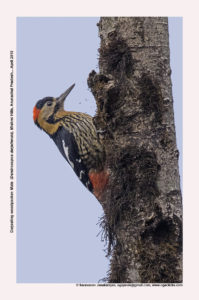Darjeeling Woodpecker

Darjeeling Woodpecker Dendrocopos darjellensis
Etymology:
- Dendrocopos : Greek word dendrontree; koposstriking
- Darjellensis : From Darjeeling in India
Vernacular Names: Lepcha: Sadyer mong prek
Distribution in India: Resident in Himalayas and North Eastin India.
Description: Size of 23–25 cm; wt. of 61–87 g. The male has whitish lower forehead, black upper forehead and crown, narrow red nape patch, black hindneck. It has white lores, white sides of head tinged buff, golden-yellow to deep orange-buff sides of neck; black malar stripe extending to lower rear ear-coverts and down to sides of upper breast. The upperparts are black, wings browner, inner coverts are white, flight-feathers are narrowly barred white; uppertail is black, outer 1–3 feather pairs are barred white to pale buff. The chin to upper breast is brownish-buff to buff-brown, paler on lower breast, more yellow on flanks and belly, breast sides and lower breast have heavy black streaking, flanks and belly are more barred. The undertail-coverts are pinkish-red. It has long straight bill that is dark grey to blackish, pale grey lower mandible with greener or ivory-coloured base; iris is red to red-brown, orbital skin is slaty-grey; legs are grey-green. The female has red of nape replaced by black. The juvenile is like adult, but lacks golden patch on neck, is duller below with streaked throat, more barred belly and flanks, duller paler red on undertail-coverts, eyes are dark brown, male has dull red crown, female has small red central patch or red tips but red may be lacking.
Habitat: It is found in high-elevation forest, cloud forest with moss-covered trees, open woodland; also evergreen and coniferous forest, and rhododendron woods. It is found from 1500m–4000 m.
Food habits: It eats larvae of wood-boring insects; also adults, larvae and pupae of other insects. It forages singly or in pairs; will also join mixed-species flocks. It exploits all levels of habitat, visiting fallen logs, tree trunks and canopy. Mossy and dead surfaces are carefully inspected and debris removed. Forceful pecking is common technique, and also uses gleaning and probing.
Breeding habits: They breed in Apr–June in India. The breeding display is a moderate crest-raising. The nest-hole is excavated at 1–2 m in tree. They lay a clutch of 2–4 eggs. The chicks fed by both parents.